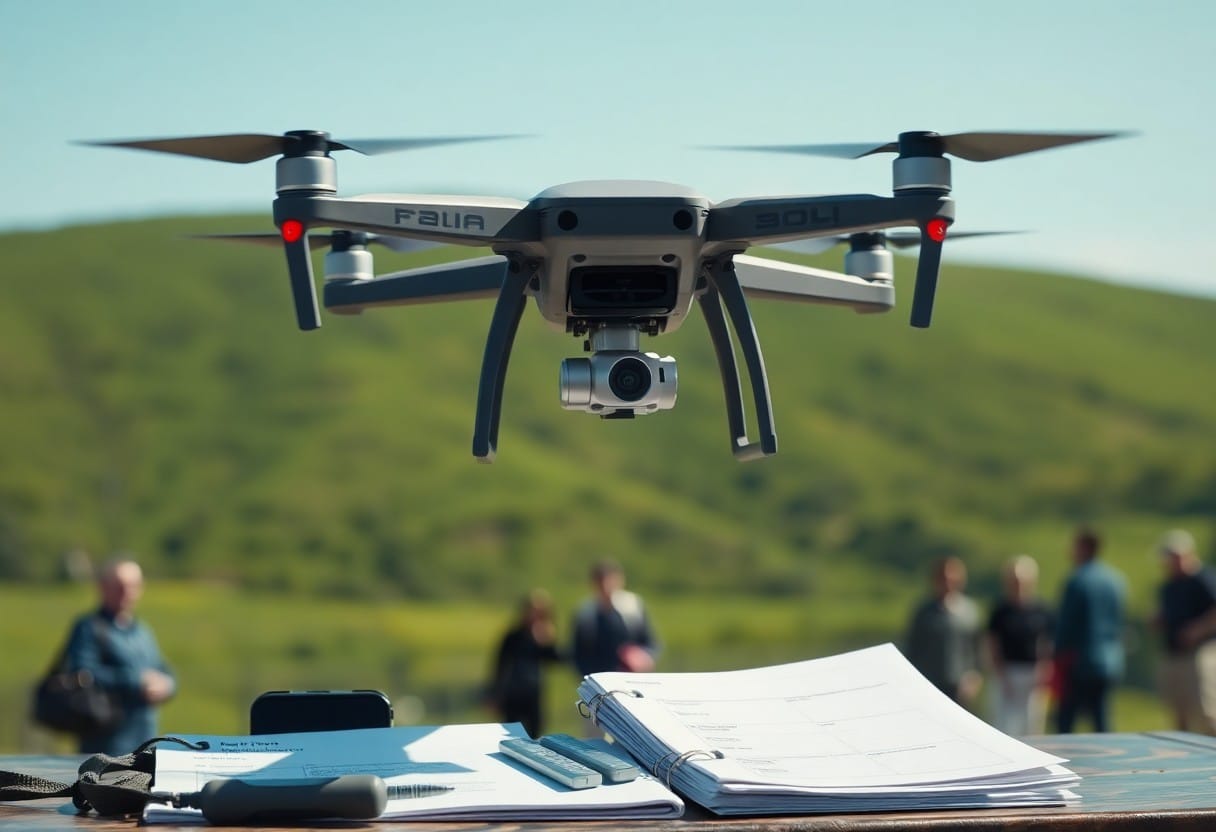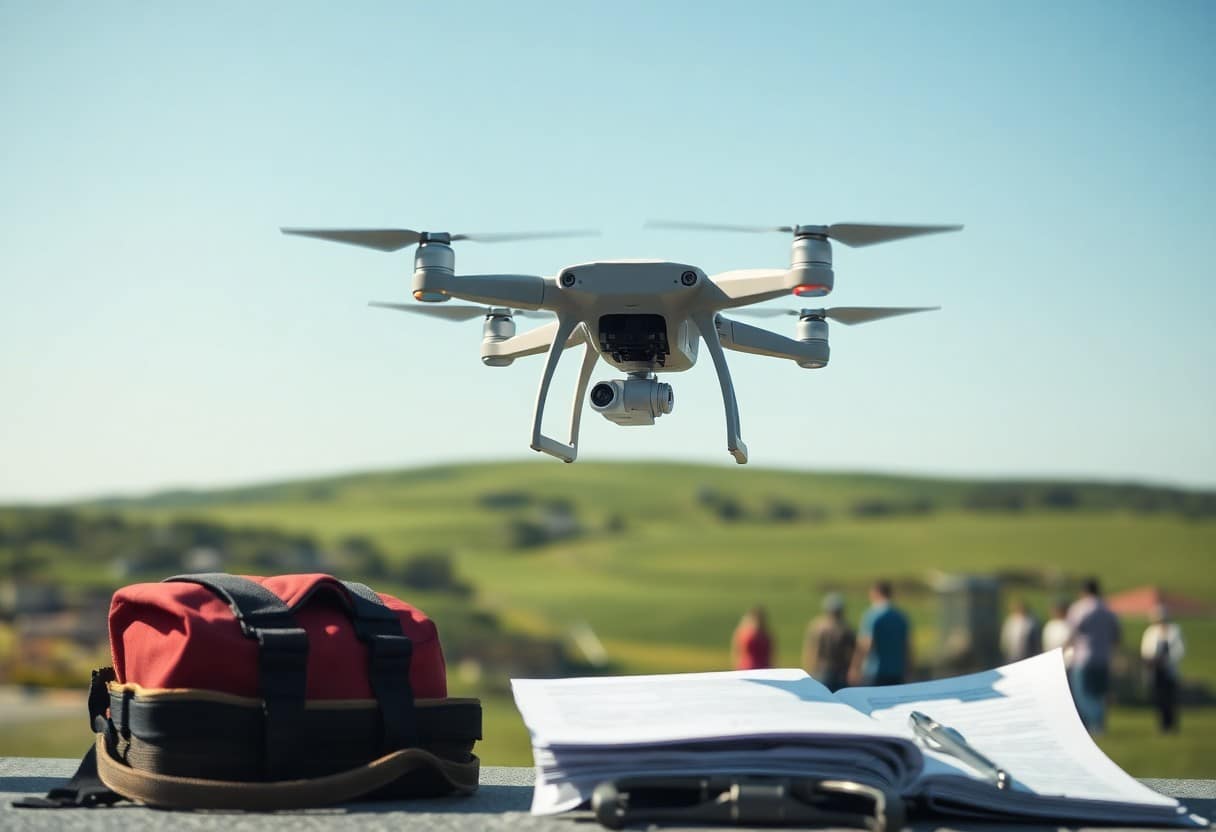Unmanned Aircraft Regulations - 7 Steps to Ensure Compliance and Safety
When operating a drone, it is important to follow the rules and regulations to ensure that your flying activities are safe and legally compliant. This article will guide you throughSeven Key StepsHelp youFollow the Drone RulesIn order to avoid potential legal risks and safety incidents, it is important to read and implement these rules. Being aware of these rules not only protects you, but also protects the safety of others and property, so be sure to read and implement these recommendations carefully.

Summary of key points:
- Understanding Laws and Regulations: Be familiar with and comply with local drone regulations and policies.
- Obtaining the necessary licenses: Ensure that all necessary flight authorizations have been obtained before operation.
- Keep your distance.: Observe safe distances between the drone and humans, buildings and other obstacles.
- Conducting risk assessment: Conduct a detailed risk assessment before flying to ensure safety.
- Regular Maintenance: Ensure regular inspection and maintenance of drone equipment to minimize the risk of failure.
- Receiving Training: Provide operators with adequate training and guidance to cope with unforeseen events.
- Establishing a Contingency Plan: Develop emergency response programs to respond quickly and effectively to potential incidents or problems.
Understanding Drone Regulations
When you operate a drone, knowing the laws and regulations is the first step in ensuring safety and compliance. Whether it's for business or personal use, complying with the law not only minimizes liability, but also ensures your safety and the safety of others. Being aware of the basic drone laws can help you plan your flights effectively and avoid potential risks and fines.
Federal Aviation Administration (FAA) Guidelines
The Federal Aviation Administration (FAA) has established a series of guidelines designed to promote the safe operation of unmanned aircraft. These guidelines require you to obtain proper registration, understand flight restrictions, and comply with airspace regulations before flying. Ensuring that you operate your drone in compliance with these guidelines can reduce the chance of an accident.
Local and state government regulations
In addition to federal regulations, you will need to follow local and state regulations, which may vary from location to location and cover such things as permit requirements for drone operations, no-fly zones, and altitude restrictions. Understanding and following these regulations is critical to keeping your community safe and flying legally.
Local law requirements may includeStricter Privacy Lawsas well asFlight Prohibition in Specified AreasIf the aircraft is not in a crowded area, such as near a school or park, the aircraft may be required to pass specific safety inspections or operate at specific times. Some states may also require aircraft to pass specific safety inspections or operate at specific times. In addition, failure to follow local regulations may result inHigh fines or criminal prosecutionYou must therefore regularly check and update the drone regulations in your area to ensure that your drone operation is legal and safe. Therefore, it is important that you regularly check and update the drone regulations for your area to ensure that your drone operations are legal and safe.

Prepare for Remote Pilot Certification
Before you can prepare for your Remote Control Pilot certification, you need to understand the requirements and regulations. It's not just about passing the test, it's about ensuring your safety and the safety of others. Learn about10 Steps to Mastering the Rules for Commercial Use of DronesThis will help you make informed decisions in the real world.
Qualifications
To apply for a remote pilot certificate, you will need to meet certain eligibility requirements. These usually include an age limit (at least 16 years old), good English language skills, and a clean criminal record. Proving that you have these basic qualifications is an important first step in obtaining your certification.
Learning and Examination Process
The study and examination process is the key to earning your remote pilot certification. You'll need an in-depth understanding of topics such as rules, aviation knowledge, flight operations and the effects of weather. After completing the course, you will take a theoretical exam that will accurately test your knowledge and skills and ensure your safety while flying.
existLearning and Examination ProcessIn the test, it is recommended that you use a variety of resources to prepare, including textbooks, online courses, and practice exams. These study materials will help you familiarize yourself with the exam and improve your pass rate. Don't forget to be well-informed before you actually fly!Operation of the droneup toEmergency ResponseThis not only ensures your compliance, but also increases your confidence and reduces the risk of accidents during operation.

Aircraft Registration and Maintenance
Before operating the drone, make sure you have properly completed theAircraft Registrationrespond in singingDaily MaintenanceIt's vital. With proper registration and regular inspections, you can not only avoid legal problems, but also ensure safe flights and reduce the risk of accidents.
Register your drone
Under local law, it is not possible to carry out any drone operations forRegisterIt's a legal obligation that not only helps you stay in compliance while flying, but also makes it easier for law enforcement agencies to identify your equipment if there is a problem.
Daily maintenance and safety inspections
In order to ensure that your drone is flying with thesafetyRegular maintenance and inspections are essential. This includes checking propellers, batteries and all electronics to ensure they are functioning properly.
proceedDaily Maintenancerespond in singingSecurity CheckWhen flying your drone, you should regularly check the following items: propellers for cracks or damage, battery charge status and life, and the functional stability of all communication equipment. Keeping this equipment in good condition not only extends the life of your drone, but also significantly reduces the risk of accidents during flight. A simple pre-flight check before each flight will give you peace of mind that you are enjoying your flight.
Flight Operations and Safety Regulations
When operating a UAV, it is important to follow proper flight operations and safety protocols to ensure your safety and the safety of others. By having a detailed plan and following the rules, you can minimize accidents and enhance your flying experience.
Pre-takeoff planning procedures
Prior to takeoff, you should conduct a detailed planning process that includes checking weather conditions, airspace restrictions in the flight area, and equipment inspections. Ensuring that all participants understand the flight plan, including the exact locations of takeoff and landing, makes the entire mission safer and more efficient.
Safety measures in flight
During flight, you must remain alert at all times and follow safety measures to protect yourself and others. This includes continuously monitoring the performance of the drone, regularly checking signal strength, and maintaining communication with ground control.
existFlyingBe careful to safeguard the safety of your unmanned aircraft.safetyThis is extremely important. It is recommended that you regularly check the data of your aircraft, such as battery level, flight altitude and GPS signals. If you notice any abnormalities, you should immediately perform aEmergency proceduresThe safety of the drone is also important to ensure its safe return to the ground, such as adjusting the flight altitude or preparing for an emergency landing. Being aware of your surroundings and avoiding conflicts with other aircraft are key elements of flight safety.
Reporting and Documentation Requirements
There are certain reporting and documentation requirements you must follow when operating a drone to ensure compliance and safety. Keeping good records not only reduces the risk of accidents, but also supports you when faced with legal and insurance queries. See alsoWhat aerial composition tips make your drone photography stand out?for further advice.
Incident Reporting Procedures
In the event of an incident, you should immediately initiate the incident reporting process and ensure that you record all key details, including time, location, people involved and the sequence of events. Depending on local laws, this information may need to be reported within a specific time frame. Following proper procedures will help speed up the investigation and minimize future liabilities.
Record Keeping and Compliance Checks
For companies operating drones.Record KeepingIt's important. You need to maintain flight records, repair and maintenance records, and operator qualifications. Conduct regularCompliance CheckThis ensures that all documents are complete and compliant, which is not only required for legal compliance, but also helps to improve the efficiency of your business operations.
When it comes to record keeping and compliance checks, you must pay attention to every detail. For example, review flight records regularly to check for any anomalies and update operator certificates in a timely manner. In addition, make sure all maintenance work is documented to avoid unnecessary legal problems and financial losses. Maintaining good records and compliance is not only about complying with the law, it is also about enhancing the image and professionalism of your business.
Future Trends in Drone Regulation
With the rapid development of drone technology, future drone regulations will become more stringent and comprehensive. These changes will not only affect flight safety, but also important issues such as privacy and public safety. Learn more about these upcoming changes and refer to theStep by Step - The 6 Best Techniques for Drone 3D ModelingWe will help you ensure compliance and safety.
Technological Evolution and Its Impact
Drone technology continues to evolve, which not only changes the way you fly, but also poses new challenges for regulation. For example, the introduction of autopilot technology and artificial intelligence will likely lead to previously unforeseen operational capabilities and risks. As a result, you need to remain keenly aware of these new technologies and their potential impact on regulation.
Anticipated Regulatory Changes
As drone use grows, new regulatory changes are sure to come. Future regulations may emphasize
More stringent flight authorizations, especially in urban areas. In addition, training and licensing requirements may become more stringent to ensure operator safety and compliance.
TheseAnticipated Regulatory Changesmay affect the way you use the drone. This is especially true whenBusiness OperationsIn the field of aviation, the compliance requirements will become more and more demanding. Government agencies may require more stringent flight operator's manuals, as well as ensuring that you are fully aware of all relevant regulations. This is not only for the sake of public safety, but also for the continued growth of the industry. Therefore, as a drone operator, it's important that you actively update your knowledge of the regulations to keep up with the changing environment. Taking the time to carefully study these regulatory changes will be key to your future success.
Drone Rules - Seven Steps to Ensure Compliance and Safety
When operating a drone, it's important to follow the seven steps of compliance and safety. First, you need to know your local laws and regulations, and register your drone according to the relevant requirements. Next, make sure your drone has the necessary insurance. At the same time, conduct regular maintenance and inspections to ensure the safe operation of your equipment. You should also learn basic flight operation skills and pay attention to weather changes. In addition, plan appropriate flight paths and avoid no-fly zones and crowded areas to ensure the safety of others. By taking these steps, you can enhance your flying skills and ensure that you are flying in compliance.
Frequently Asked Questions
Q: What are the rules of drone operation?
A: Rules for the operation of a drone are regulations for drone users to ensure the safe flight and legal operation of a drone. These rules include airspace restrictions, flight altitude, licensing requirements and privacy protection requirements.
Q: How can I ensure that my drone is operated in accordance with safety standards?
A: To ensure that drone operations meet safety standards, users should comply with local drone laws and regulations, obtain the necessary permits, conduct pre-flight inspections, and fly within the permitted airspace.
Q: What licenses do I need to operate a drone?
A: Permit requirements vary from country to country and region to region. In many places, users need to apply for a drone operator's license, especially for commercial use or flying in specific airspace.
Q: What are the safety procedures for operating a drone?
A: The steps to safely operate a drone include: 1) Conduct a pre-flight inspection to ensure that the equipment is in good condition; 2) Understand local laws and airspace restrictions; 3) Ensure that weather conditions are suitable for flight; 4) Monitor the drone's flight status; 5) Avoid flying over crowds; 6) Respect other people's privacy; and 7) Conduct a post-flight inspection of the equipment.
Q: Are there any restrictions on flight time and altitude?
A: Yes, most areas have specific restrictions on the time and altitude at which drones may be flown. Generally, drones are not allowed to fly more than 400 feet in the air (about 120 meters) and are not allowed to fly at night unless they have a night flight permit.
Q: How do I handle emergencies during a flight?
A: When encountering an emergency situation during flight, the user should immediately assess the situation calmly and follow the emergency procedures, such as selecting a safe landing area, turning off the drone's power, etc. In addition, it is necessary to conduct regular emergency drills. In addition, regular emergency drills are also necessary.
Q: What are the consequences of violating the drone rules?
A: Violations of the Drone Rules may result in legal consequences, including fines, drone forfeiture, and even criminal prosecution. Continued violations may affect future eligibility for a license.




